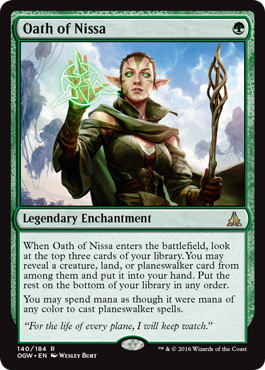Saheeli Sisters in Modern
Since the last Modern GPs, it just seems like everyone agrees that 《Death's Shadow》 is the best deck by a decent margin, combining blistering speed, stability and resilience all the while giving the pilot tons of room to outplay their opponent. And you know what? I think that everyone is right. The deck is good, and I would expect it to keep posting good results in the future.
I happen to have a lot of experience with it, since I was part of team Eureka at PT Washington, where we all played it what was – I think – the first time a pro team gave the deck actual credit. Our performance with it was really good, but it was overshadowed by the rise of the Eldrazi decks , which makes sense if you look at what those decks did to the format. Long story short, I kept playing 《Death's Shadow》 zoo for a while and knew it in and out before the bans.
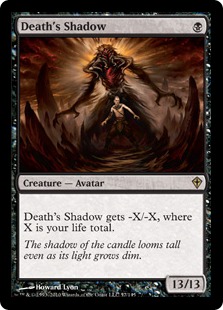 | 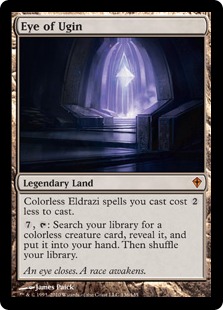 |  |
But this article is not about 《Death's Shadow》, it is about how you can fight it. See, when a deck is that good, changing one or two cards is just not going to cut it: this is no glass cannon, and you will not find a specific card that would just stop the deck in its tracks. No, if you want to have a good match-up, your entire strategy needs to be good against it. With that in mind, I just went back to my extensive talks with other 《Death's Shadow》 aficionados, namely MOCS champion Magnus Lantto, and checked up on the “nightmare” match-ups we identified back then. The worst one, we all agreed, was soul sisters. This is where I (finally!) get to the point of this article.
Why was Soul Sisters so good against Death’s Shadow?For those of you who are not familiar with Soul Sisters, the deck usually looks something like this:
|
23《Plains》 -Lands (23)- 4《Ajani's Pridemate》 1《Aven Mindcensor》 3《Martyr of Sands》 4《Ranger of Eos》 4《Serra Ascendant》 3《Soul Warden》 4《Soul's Attendant》 4《Squadron Hawk》 -Creatures (27)- |
1《Brave the Elements》 2《Path to Exile》 4《Spectral Procession》 3《Honor of the Pure》 -Spells (10)- |
1《Aven Mindcensor》 2《Ethersworn Canonist》 2《Ghostly Prison》 3《Rest in Peace》 2《Rule of Law》 3《Stony Silence》 2《Suppression Field》 -Sideboard (15)- |

The idea of the deck is to play a relatively weak synergistic aggro plan, while gaining tons of life, which is quite bad in general (we’ll come back to that), but extremely efficient against other aggressive strategies because it is just so hard to race it. Specifically, against 《Death's Shadow》, you present them with a puzzle they cannot usually solve: they need to go low enough to deal significant damage to you, and kill you from a very high life total while not dying to your creatures..
This is basically a race where you start around 30, and they start around 10: it is not easy. And it is not about one specific card, but about the way both decks play out in general, meaning that A: you will win very consistently since you do not need to “draw the right part of your deck” and B: they cannot really adjust their sideboard or game plan to make things better. This is just one of those match-ups where they lose, which is absolutely ok because no one in their right mind would play a deck as bad as Soul Sisters.
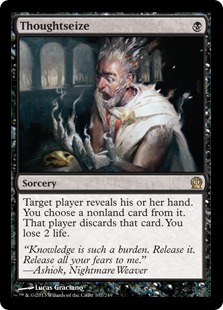 | 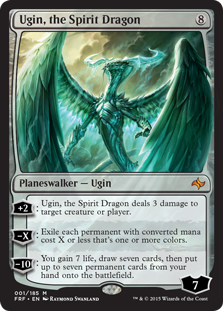 | 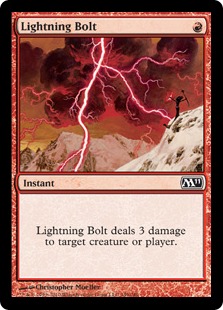 |
So, wait. Why is the deck so bad in the first place? Well, it is simple enough: not every deck is trying to race you. Jund (or Junk) will just run you out of resources, and kill you from whatever life total you have once they did it. Combo decks will just, well, combo you while you try to pressure them with mediocre beaters and cute synergies. Tron decks will go over the top of you. Control decks will have very little trouble controlling you. Whenever you gaining life does not matter, you are left with a weak aggro deck. Souls Sisters have been played now and then, but never put up good results, and for good reasons.
Turning Soul Sisters into a real deckBut things change. What if, instead of playing a lifegain/aggro deck, you played a midrange deck that can combo-off on turn 3, gain tons of life, or assemble an army of 3/3 golems and grind out the opponent? Now, that is much harder to attack.
|
4《Windswept Heath》 2《Wooded Foothills》 2《Grove of the Burnwillows》 2《Razorverge Thicket》 2《Temple Garden》 1《Hallowed Fountain》 1《Breeding Pool》 1《Stomping Ground》 1《Sacred Foundry》 1《Forest》 1《Plains》 1《Gavony Township》 -Lands (19)- 4《Soul Warden》 1《Soul's Attendant》 4《Noble Hierarch》 2《Birds of Paradise》 2《Anafenza, Kin-Tree Spirit》 4《Blade Splicer》 1《Viridian Shaman》 1《Eternal Witness》 1《Fiend Hunter》 4《Felidar Guardian》 1《Kiki-Jiki, Mirror Breaker》 1《Reveillark》 1《Sun Titan》 -Creatures (27)- |
2《Chord of Calling》 4《Path to Exile》 4《Oath of Nissa》 4《Saheeli Rai》 -Spells (14)- |

Let me show you how I came up with the deck, step by step. The first reasoning was that 《Saheeli Rai》 would be much better in Modern than it is in standard: the clone effect would have much better targets outside of the combo, and more importantly, you could very easily cast it on turn 2, which is hugely threatening to just about any deck. I mean, the very simple draw of turn one 《Noble Hierarch》, turn two 《Saheeli Rai》 is a headache for your opponent: they simply die to 《Felidar Guardian》 on turn 3 if they tap out, but they have to play something to pressure 《Saheeli Rai》, since they probably do not have much to do it with yet (《Wild Nacatl》, at best? I am SO not impressed).
Once you start playing 《Saheeli Rai》 and 《Felidar Guardian》, it is only natural to play cards that work well with both, I.e. cards with enter the battlefield effects. The deck was looking more and more like an updated version of the old “Kiki-Pod” deck, that had a combo finish but was mostly great because of its ability to grind out just any deck at all. So I already knew that I would end up with a deck that would be able to regularly kill on turn 3 in combo mirrors (which, to me, just solves those match-ups), while having a lot of staying power if games went long.
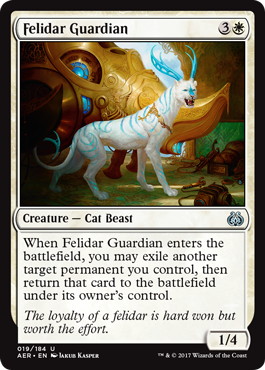 |  | 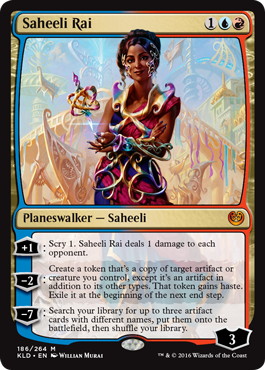 |
This is where 《Soul Warden》 comes in. It is just a beautiful card in the deck: against aggro or midrange decks, it lets you gain “some” life (quite easily two life a turn), which in turn buys time to start the grind and assemble enough value to grind out other midrange decks, which would be quite hard to beat otherwise. But it also gives you access to a secondary combo, which is 《Soul Warden》 + 2 《Felidar Guardian》 for infinite life. It might sound complicated, but since neither the Warden nor the Guardian are the kind of targets your opponent would like to spend any removal on, it is surprisingly easy to assemble.
The rest of the deck just synergizes nicely with those core ideas. On the one hand, you have the “other” pieces. 《Blade Splicer》 is the aggressive part of the deck by itself, and even though it may look like it will not be enough to mount an offense, it is actually very easy to assemble an army of golems once you draw the first one. It also nets you two life with a 《Soul Warden》, and makes it very easy to cast 《Chord of Calling》 for a high enough number.
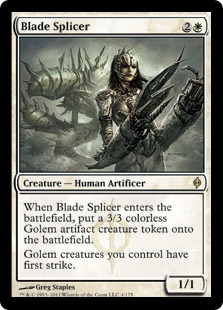 | 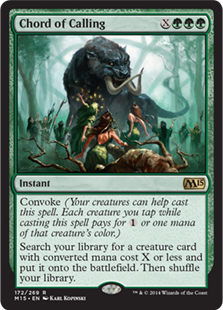 | 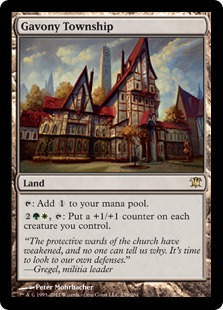 |
This plan is fairly well complemented by the greedy inclusion of 《Gavony Township》, the lets you use the extra turns that 《Soul Warden》 bought you to in turn slowly grow your random critters to rather beefy proportions. This is also fairly important against decks like Abzan, that could theoretically beat you after you reached infinite life just by clogging the board and waiting for you to draw your entire deck: this will never happen with 《Gavony Township》.
Then, you have a few extra combo outlets. 《Kiki-Jiki, Mirror Breaker》 is just a 《Saheeli Rai》 that you can tutor for, so no explanations needed here. 《Sun Titan》 might be a little more tricky, so I’ll explain why it was included (other than because the card is super powerful when you can cast it, of course).
 |  |  |
If you ever have have two 《Saheeli Rai》 in your graveyard, or one in your graveyard and the other into play, then 《Sun Titan》 lets you combo out of nowhere: you return a Saheeli to the battlefield, copy the Titan, return the other Saheeli thanks to the copy, and sacrifice the first Saheeli to the legend rule. Now, you are back to step one, except that you have an extra 《Sun Titan》 ready to rumble. You can now spawn any number of 《Sun Titan》, and bash with all of them, which is quite a spectacular way to close out a game from an empty board. This is by far the coolest kill I scored in a while, and it tends to happen a lot in the slower match-ups.
Finally, you have two 《Anafenza, Kin-Tree Spirit》 in the deck: they support your beatdown plan very nicely, but they can also be used as yet another combo if you know how to stack your triggers: once you have Anafenza and Felidar on the battlefield, play the second Felidar. You target the first Felidar, with the bolster trigger on the stack.
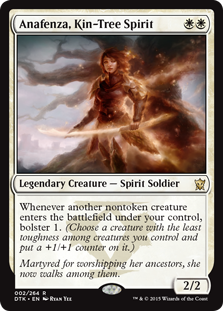 |  |  |
Here, the trick is that you can decide to resolve the blink effect before the bolster effect. When you do that, the first felidar blinks, and you get a new bolster trigger (the first one is still on the stack, of course) and a new felidar trigger: resolve that one first, and so on, and so on, until you have resolved all of your felidar triggers but none of your bolster triggers, and every creature you control is now absurdly large. It might take a while to explain, but it definitely works and it is a super elegant way to win.
The mana acceleration part is self-explanatory: it just lets you be faster than most combo decks in the pseudo-mirror, and helps cast 《Chord of Calling》 for 4 or more. Specifically, as I mentioned earlier having the option to drop a turn-2 《Saheeli Rai》 is immensely threatening. Finally, you have a few great tools to help smooth out your draw and assemble whatever interaction is needed.
The first one is 《Oath of Nissa》, and I would easily call it the best card in the deck: it plays out a little bit like a “better” 《Ponder》, and “better than a banned card” is pretty high praise. The second is long-time classic 《$Chord of calling,》 giving you a decent tutor and enabling a little bit of instant speed action should you ever need it. It is also a sweet tool to engineer the combo over the course of a few turns: chord for an 《Eternal Witness》, get your chord back, chord for a 《Felidar Guardian》, blink your witness to get the chord back again, and chord for Kiki-Jiki to combo out. The beauty of it is that each new creature nets you an extra mana, so you will not need to draw anymore lands to keep ramping all the way to X=5.
Should you play this deck right now?Certainly not in it’s current form. See, in my articles, I try to let you in on where I am in my testing. Right now, there are tons of options to choose from and I did not have time to test them all yet. The sideboard, in particular, is still a question mark. You definitely want to play all the one-offs that was good in birthing pod (《Viridian Shaman》, 《Banisher Priest》, 《Kitchen Finks》 and so on).
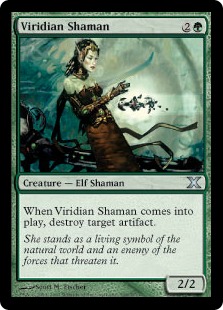 | 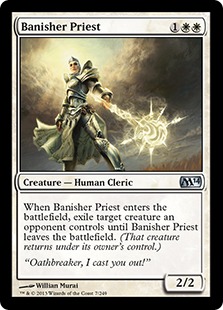 | 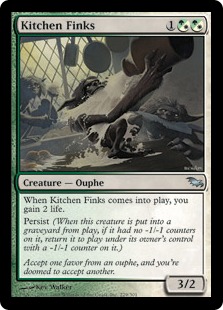 |
but the tricky part is to identify the match-ups where you want to move away from the combo post-board, and those where you want to be defending it with something like 《Spellskite》. Oh, by the way, note that 《Spellskite》 does absolutely nothing against us, which is a very nice bonus given how popular the card is.
Finally, please note that only 《Eternal Witness》 cares about your graveyard in this deck. This is a very relevant point, because it means that you can run cards like 《Rest in Peace》 without any collateral damage, which is really a nice plus when building a sideboard,
Anyway, I will be working on this deck for GP Copenhagen and GP Vegas: if you like creature-based combo decks, I really suggest you do too. I mean, this is basically a crossover between a 《Birthing Pod》 deck and a 《Splinter Twin》 deck: how much sweeter can it get?
Until next time,
Pierre Dagen
Cards found in the Article
Share in Twitter
Share in Facebook
 Pierre Dagen
Pierre Dagen
One of Europe’s most well-recognized players, whom at Pro Tour: Theros squared off against his “Les Bleus” teammate Jeremy Dezani in a Mono-Blue Devotion mirror match in the finals, a game to go down in magic history. Other notable achievements include a second PT top8 in Honolulu 2016, 3 GP Top 8’s, and 3rd place at the World Magic Cup 2015 as captain of the French team.

Related Articles
- 2017/03/09
- 4C Saheeli Deckguide
- Lukas Blohon


